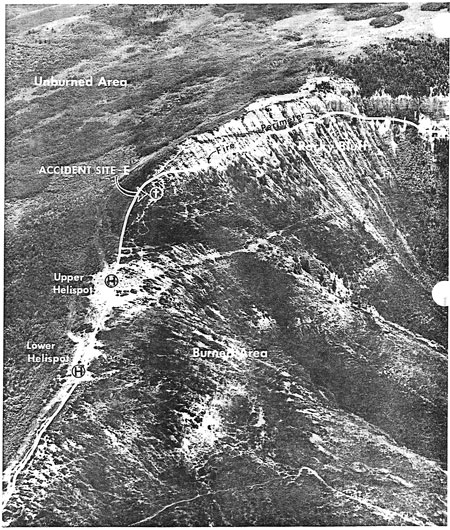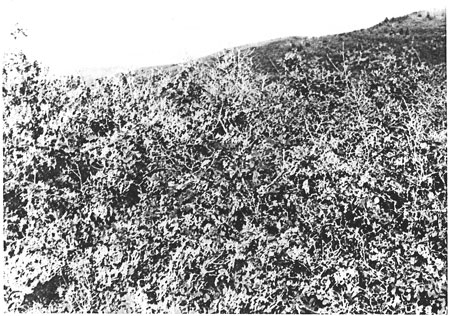
Accident Report
BATTLEMENT CREEK FIRE
Fatalities & Injury
July 17, 1976
- Location
- National
Fire Situation
- Fire
Environment
- Weather
- Topography
- Vegetation
and Fuels
- Origin
and Initial Suppression Effort
II. Fire Behavior and Burning Sequence on July 16 and 17, 1976
- General Situation
- Prior Weather
- Fire Behavior Appraisal
- Fire Behavior July 16
- Burning Sequence July 17
- Chaparral Model Nomograph
- Fire Behavior Summary
III. Suppression Effort and Accident Sequence
- Accident Sequence
- Post-Accident Rescue and Medical Action
IV. Investigation
V. Organization and Management
- Fire Overhead and Crew Assignments 7/16-7/17/76
- Overhead Qualification and Experience
- Crew Qualification and Experience
- Logistical Support
- Fire Planning and Intelligence
- Aviation Management Activity
- Mechanical Factors
- Physical Factors
- Human Factors
- Crew
- Overhead
- Management Factors
VII. APPENDIX
No Fire
Shelters in British Columbia, July 25, 2005 safety bulletin explaining
their change in policy, .pdf file, 2.2 mb
|
Accident
Report
BATTLEMENT CREEK FIRE
Fatalities & Injury
July 17, 1976
C. Fire Environment (continued)
3. Vegetation and Fuels
The vegetation of Battlement Creek reflects the arid climate. The dominant
vegetation in the fire area is Gambel's oak-mountain mahogany. But vegetational
types in the drainage vary according to elevation and exposure. On north-facing
slopes, the vegetation begins at the stream bottoms with a mixture of
pinon-juniper and sagebrush. As the elevation increases, the sagebrush
decreases, and a mixed mountain shrub type gradually replaces pinon-juniper.
Grass and sagebrush types are common on the ridges and drainage bottoms
(cured cheatgrass was present in openings at lower elevations). Aspen
and spruce-fir may be found at lower elevations along draws and moist
areas. Some aspen occurred in the fire area at the head of the south draw;
and prostrate Douglas-fir was found along the high ridge east of the south
draw.
The mixed mountain shrub type was the primary plant community contributing
to fire spread on Saturday, July 17. The dominant species in this community
are Gambel's oak, mountain mahogany, serviceberry, and snowberry. The
shrub community was dense and all but impenetrable in many places. The
shrubs contained a large amount of fine dead branches throughout the canopy
(fig. 5). Gambel's oak ranged as high as 10-12 feet or higher; it was
4-6 feet high along the ridgeline above the chute (north draw). This ridgeline,
the site of the accident, also contained several small openings and game
trails (fig. 6).

Figure 5.--Serviceberry,
mountain mohogany, and Gambel's oak in the Battlement Creek fire contained
a large amount of fine, dead branches throughout the canopy.

Figure 6.--The ridgeline where the fatalities occurred was characterized
by 4- to 6-foot brush, small openings, and game trails. Oblique aerial
photgraph, July 19, 1976.
A very significant weather event occurred 1 month prior to the fire which
adversely affected the fuel complex. An extensive frost on June 14 killed
more than 50 percent of the leaves on the Gambel's oak (other shrub species
did not appear to be materially affected). Many of the dead leaves were
still retained on the plants at the time of the fire (fig. 7). Shedding
oak leaves contributed to a 1-2-inch litter layer beneath the mixed mountain
shrub type. Pinon pine and juniper trees were scattered through the oak-mahogany
type, primarily along the ridge north of the north draw.

Figure 7.--Many of the frost-killed Gambel's oak leaves were still retained
in the shrub crowns at the time of the fire.
Fuel moisture samples were collected at 1830 on July 20 at 8,800 feet
on the ridge above the fire area:
Sample
|
Average moisture
content (%) |
Dead oak leaves (shrub canopy)
|
11.4 |
Leaf litter on ground
|
13.7 |
Dead oak branches (1/4-inch)
|
12.4 |
Green oak leaves
|
166.5 |
| Living oak stems (1/4-inch) |
193.8 |
The dead oak leaves in the shrub canopy and other fine fuels could have
been at 7-8 percent moisture content, or less, at the time of the fire
run on Saturday, July 17.
The June frost significantly increased the amount of available fuel in
the Battlement Greek area by contributing to the dieback of the oak leaves.
One individual remarked that fire behavior conditions seemed 2-3 weeks
early for this time of year.
Chemical analyses of the Gambel's oak leaves were conducted at the Northern
Forest Fire Laboratory in Missoula:
| |
Green leaves
|
Dead leaves in crown |
Crude fat (%)*
|
1.60 |
.52 |
Total ash (%)
|
3.18 |
2.50 |
Low heat of combustion
(B.t.u./lb.)* |
7886 |
7782 |
* Samples were not frozen.
Escape of volatiles might tend to make these values low.
Thus, the crude fat content, or amount of volatile waxes, oils, and resins,
was quite low. Much lower than the 8-12 percent reported for southern
California chaparral.
<<<
continue reading—Battlement Creek Fire, Origin and Initial Suppression
Effort >>>
|
